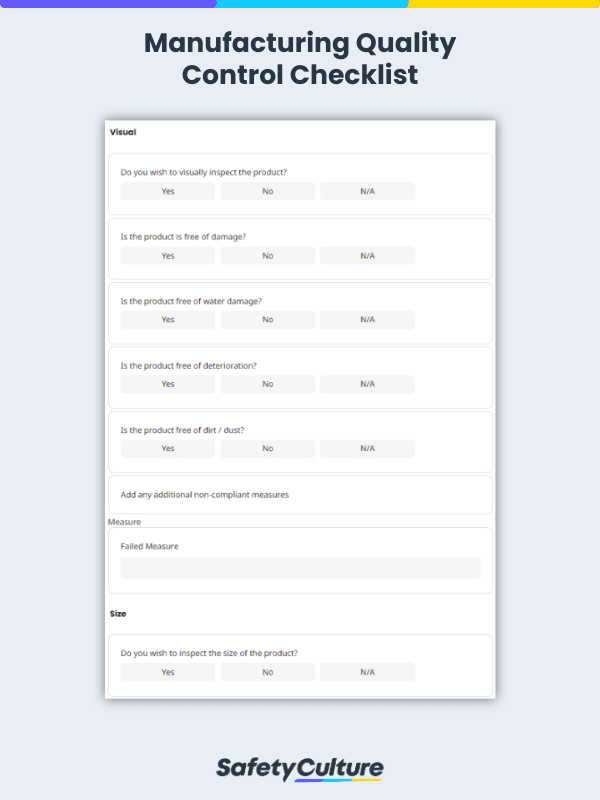What is a Quality Control Inspection?
A quality control inspection is an assessment of a product’s quality against predetermined specifications. Inspection in quality control identifies defects and other signs of non-conformance with the organization’s quality standards. Quality control inspectors also evaluate a variety of product-related factors, such as cleanliness, size, color, weight, material, operation, and packaging.
Is Quality Control the Same as Inspection?
Quality control is not the same as inspection. Rather, inspection is part of quality control, such is the case with Quality Control (QC) inspections. Aside from inspection, quality control procedures and quality audits help develop the quality control of an organization as a whole. Solely relying on inspection for QC or equating QC with inspection can lead to neglect in other areas of quality control.
What are the 4 Types of Quality Control?
While there are different approaches to the types of quality control, the majority of publicly available sources focus on the types of quality inspections, which are process, product, 100% mode, during production, pre-production, container loading, and pre-shipment. However, with this approach, there are more than 4 types of quality control.
Here are the proposed 4 types of quality control, which emphasize that QC covers several parts and/or aspects of an organization’s production workflow:
- Compliance-based quality control – complying with industry standards like ISO 9001
- Output-based quality control – adhering to the six sigma or zero defects philosophy
- Organization-based quality control – shaping QC according to quality objectives and improving QC by implementing changes to the organization’s structure, culture, or standard procedures
- Data-driven quality control – using inspection data to identify areas of production that consistently fail QC checks
What is the Role of Quality Control Inspectors?
The role of quality control inspectors is to accept or reject products based on QC inspection test results, which usually include recommendations for the quality auditor. Quality control inspectors also monitor the production workflows of their respective organizations and check if there are any errors in processes and equipment that could potentially cause product deviations. Their main goal is to isolate and remove defective, low-quality, or unsafe products.
What are the Common Steps in Quality Control Inspection?
The common steps in quality control inspection are the following:
- Identify the product to be inspected and record its ID, Stock Keeping Unit (SKU), serial, or item reference number.
- List the processes involved in making the product; the locations of the product, its materials, or equipment used to manufacture it; and the teams involved and what they were responsible for.
- Determine the inspection type, sampling standard, plan, and/or level.
- Evaluate the product’s visual appearance.
- Check measurements/dimensions.
- Compare product characteristics with design specifications.
- Identify and describe any defects and form corrective actions for them.
- Apply on-site tests and provide your assessment on the results.
- Inspect the product’s packaging.
- State if the product passes or fails the inspection and provide recommendations to the quality auditor or Quality Assurance (QA) team.
3 Principles to Follow in Creating Effective QC Inspection Checklist
“Quality is everyone’s responsibility,” claimed the renowned engineer, professor, and management consultant W. Edwards Deming. Quality control, however, is a continuous process. A process that becomes harder to complete when the complexities of large-scale production and servicing are introduced. To stay true to a company’s promise of quality, something as simple as an effective QC inspection checklist can be the X factor.
Below are the principles QC inspection checklists must follow to become effective:
1. It must consider input from different stakeholders
Creating a product or rendering a service is a step-by-step process. Often, each step is handled by a dedicated department specializing in that section. For this reason, acquiring input from the different experts that are actually involved in the process is important since it informs your QC inspection checklist with data and insights founded on solid bases.
2. It must be uniform for all sites and branches
A good QC inspection checklist informed by the expertise and insights from relevant stakeholders is only as good as its effective implementation. To keep quality output consistent throughout the entire organization, quality assurance officers must ensure that the same QC inspection checklist is being used by all sites and branches. This minimizes product quality variation between manufacturing sites and locations.
3. It must be updated regularly and whenever necessary
The processes and standards of operations evolve due to numerous factors over time. Since a QC inspection checklist serves as one of the final checkpoints before a product or service is deemed fit for delivery, organizations must ensure that the standards enforced by their QC inspection checklist is consistent with their current quality standards.


